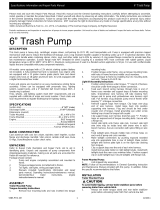
Specifications Information and Repair Parts Manual 5760-95 thru 576E-95
5760-250-00
1
09/2011
Please read and save this Repair Parts Manual. Read this manual and the General Operating Instructions carefully before attempting to assemble,
install, operate or maintain the product described. Protect yourself and others by observing all safety information. The Safety Instructions are contained
in the General Operating Instructions. Failure to comply with the safety instructions accompanying this product could result in personal injury and/or
property damage! Retain instructions for future reference. AMT reserves the right to discontinue any model or change specifications at any time without
incurring any obligation.
©2011 American Machine & Tool Co., Inc. of PA, A Subsidiary of The Gorman-Rupp Company, All Rights Reserved.
Periodic maintenance and inspection is required on all pumps to insure proper operation. Unit must be clear of debris and sediment. Inspect for leaks and loose bolts. Failure
to do so voids warranty.
Submersible Shredder Pumps
Refer to pump manual 1808-636-00 for General Operating and Safety Instructions.
DESCRIPTION
These heavy duty centrifugal Submersible Shredder Pumps are intended for use in residential, commercial, and industrial settings. Examples include:
Sewage, wastewater, and other general processing applications involving dirty liquids with small solids (see size chart below). Submersible design
means low noise and no priming issues.
Each unit is completely assembled and includes a self-cleaning, semi-open cast iron impeller featuring a tungsten carbide cutting tip for durability while
helping to break-up solids. Pumps incorporate a mechanical shaft seal with long-lasting silicon carbide wear faces and feature a secondary shaft seal
and oil chamber.
Pumps have a 3450 RPM electric motor fitted with an unfinished power cord that requires field wiring (no controls are supplied). Motors are rated
continuous duty and single phase units have automatic restart thermal overload protection. Handle liquids from 40° to 104° F (4° to 40° C). For use with
non-flammable liquids compatible with pump component materials.
MAINTENANCE
Make certain that unit is disconnected from power source before
attempting to service or remove any components!
POWER CORD REPLACEMENT
Periodically inspect power cord and replace whenever abrasion,
cracking, softening, or other signs of deterioration are found.
Refer to Figures 1 and 2.
1. Place unit on workbench in upright position. Clean dirt and
rust from around wire cover (Ref. No. 7).
2. Remove two fasteners (Ref. No. 4) which hold cord retainer
(Ref. No. 3).
3. Remove fastener(s) (Ref. No. 5) at handle (Ref. No. 6) to
free wire loom (Ref. No. 2).
4. Remove four fasteners (Ref. No. 8) which hold wire cover in
place.
5. Carefully pry cover from unit with screwdriver.
IMPORTANT: Be careful to keep rust and other debris from falling into
motor housing during cover removal.
6. Take note of proper wire configuration, and connect new
power cord (Ref. No. 1) in identical fashion.
If unsure about above information or wiring diagrams, consult an
electrician familiar with motor wiring.
7. Clean sealing flanges if necessary and reassemble pump in
reverse order.
IMPELLER INSPECTION /REPLACEMENT
If pump develops poor performance characteristics, impeller may be
worn or clogged.
IMPELLER INSPECTION
Refer to Figure 2
1. Place unit on workbench in upright position and clean rust
and buildup from around pump-to-motor flange.
2. Remove four short fasteners (Ref. No. 15) which attach
pump to motor.
3. Lift motor assembly up out of pump assembly and lay on
workbench in horizontal position. Rap down on pump body
with soft mallet if necessary to separate parts.
4. Inspect impeller (Ref. No. 26). If clog is found, remove
debris and reassemble in reverse order. If damage to
impeller is found, such as pitting, deep grooves, or
breakage, proceed to next section.
IMPELLER REPLACEMENT
1. Remove impeller fastener (Ref. No. 28) by unscrewing in
counterclockwise direction.
NOTE: To prevent motor shaft from turning, wedge a screwdriver
between impeller vane and impeller fastener (see Figure 2).
2. Slide off impeller washer (Ref. No. 27). Impeller is keyed to
motor shaft and can now be pulled free.
3. Install replacement impeller and reassemble in reverse
order.
MECHANICAL SEAL REPLACEMENT
Motor internals are protected from contact with liquid being pumped by
a mechanical shaft seal and oil cavity. When seal wears out, potential
motor life will be compromised. Therefore, periodic seal replacement is
recommended. Time interval between replacements will depend on
abrasiveness of liquid being pumped, temperature, total accumulated
runtime, etc.
IMPORTANT: Always replace seal head (Ref. No. 18) and both seal
seats (Ref. Nos. 17 & 19) at same time to insure proper mating of
components.
Refer to Figure 2
1. Disassemble pump by following directions in both “Power
Cord Replacement” and “Impeller Inspection / Replacement”
sections.
2. With unit on its side and wire cover, pump assembly, and
impeller removed, lift shaft key (Ref. No. 13) from shaft/rotor
(Ref. No. 12) using a pliers.
3. Clean rust and buildup from unit.
4. From top of unit, remove four long fasteners (Ref. No. 10)
which attach lower end bell (Ref. No. 16) to motor case (Ref.
No. 11).
5. Rap on ears of lower end bell with a soft mallet to break it
free from motor case. Then carefully guide lower end bell
along with shaft/rotor and bearing assembly out of motor
case.

Specifications Information and Repair Parts Manual 5760-95 thru 576E-95
5760-250-00
2
09/2011
Submersible Shredder Pumps
6. Drain oil from seal cavity by removing drain screw (Ref. No.
23) and seal (Ref. no. 22) from seal plate (Ref. No. 21). Then
tip components upright overtop of a catch pan until oil is
drained.
7. Remove three fasteners (Ref. No. 25) and pry out seal plate
with screwdriver. Slinger washer (Ref. No. 24) will come free
at this time.
8. Use a press or gear puller to remove shaft and bearings from
lower end bell. Shaft seal head will now be free.
IMPORTANT: Shaft seal head (with spring) has unique ends, and two
seal seats are different from one another also. Be sure to note size and
color of each before disassembly so that new parts are installed in
proper orientation.
9. Remove upper seal seat (Ref. No. 17) from lower end bell by
using a screwdriver or dowel to press on seal from rear. Do
the same for lower seal seat (Ref. No. 19) in seal plate.
10. Clean seal seat cavities before inserting new seals.
11. Carefully wipe polished surface of new seal seats with a clean
cloth.
12. Wet outside of rubber portion of seal seats with a light coating
of soapy water.
13. Press each new seal seat squarely into cavity in both seal
plate and lower end bell. If seal seat does not press squarely
into cavity, it can be adjusted into place by pushing on it
carefully with a piece of pipe or dowel. Always use a piece of
cardboard between pipe and seal seat to avoid scratching
seal seat. (This is a lapped surface and must be handled very
carefully.)
14. After each seal seat is in place, insure that it is clean and has
not been marred.
15. Using a clean cloth, wipe shaft and make certain that it is
perfectly clean.
16. Carefully guide motor shaft through seal seat and use a press
to seat bearing back into lower end bell.
17. Apply a light coating of soapy water to inside rubber portion of
seal head and slide onto shaft (be sure to start correct end
first).
18. Place seal plate back onto lower end bell being careful to
guide shaft and avoid damage to seal seat. Secure with
fasteners.
19. Press slinger washer back in place.
20. Refill cavity with oil through fill hole and reassemble in
reverse order.
Figure 1 – Impeller Removal

Specifications Information and Repair Parts Manual 5760-95 thru 576E-95
5760-250-00
3
09/2011
For Repair Parts contact dealer where pump was purchased.
Please provide following information:
-Model Number
-Serial Number (if any)
Part description and number as shown in parts list
Figure 2 – Repair Parts Illustration – 2&3 inch

Specifications Information and Repair Parts Manual 5760-95 thru 576E-95
5760-250-00
4
09/2011
Repair Parts List
Part Number for Models:
2-inch - 1HP
3-inch - 2HP
5760-95
5761-95
5763-95
Ref.
5762-95
5764-95
No.
Description
576B-95
576C-95
Qty.
1
Power Cord Kit
-110VAC, 1PH
5760-350-90
-
1
-220VAC, 1PH
5761-350-90
5763-350-90
1
-220VAC, 3PH
5762-350-90
5764-350-90
1
-440VAC, 3PH
576B-350-90
576C-350-90
1
(includes Ref. Nos. 1, 2, 3, and 4)
2
Wire Loom
Incl. w/ Ref. 1
Incl. w/ Ref. 1
1
3
Retainer
Incl. w/ Ref. 1
Incl. w/ Ref. 1
1
4
Fastener
Incl. w/ Ref. 1
Incl. w/ Ref. 1
2
5
Fastener
*
*
2
6
Handle Kit
5760-100-90
5763-100-90
1
7
Wire Cover
-
-
-
8
Fastener
*
*
4
9
Seal
Incl. w/ Ref. 35
Incl. w/ Ref. 35
1
10
Fastener
-
-
-
11
Motor Case
-
-
-
12
Shaft/Rotor
-
-
-
13
Shaft Key
-
-
-
14
Seal
Incl. w/ Ref. 35
Incl. w/ Ref. 35
1
15
Fastener
*
*
4
16
Lower End Bell
-
-
-
17
Upper Seal Seat
Incl. w/ Ref. 35
Incl. w/ Ref. 35
1
18
Seal Head
Incl. w/ Ref. 35
Incl. w/ Ref. 35
1
19
Lower Seal Seat
Incl. w/ Ref. 35
Incl. w/ Ref. 35
1
20
Seal
Incl. w/ Ref. 35
Incl. w/ Ref. 35
1
21
Seal Plate
-
-
-
22
Seal
Incl. w/ Ref. 35
Incl. w/ Ref. 35
1
23
Drain Plug
*
*
1
24
Slinger Washer
Incl. w/ Ref. 35
Incl. w/ Ref. 35
1
25
Fastener
*
*
4
26
Impeller
Incl. w/ Ref. 34
Incl. w/ Ref. 34
1
27
Impeller Washer
Incl. w/ Ref. 34
Incl. w/ Ref. 34
1
28
Impeller Fastener
Incl. w/ Ref. 34
Incl. w/ Ref. 34
1
29
Casing Kit
5760-001-95
5763-001-95
1
30
Base
Incl. w/ Ref. 34
Incl. w/ Ref. 34
1
31
Fastener
Incl. w/ Ref. 34
Incl. w/ Ref. 34
4
32
Strainer Kit
5760-170-90
5763-170-90
1
33
Fastener
*
*
3
34
Wear Plate & Impeller Kit
5760-010-90
5763-010-90
1
(includes Ref. Nos. 26, 27, 28, 30, and 31)
35
Seal Kit (not shown)
5760-300-90
5763-300-90
1
(includes Ref. Nos. 9, 14, 17, 18, 19, 20, 22, and 24)
36
Start Capacitor
-110VAC, 1PH
5760-351-00
-
1
-220VAC, 1PH
5761-351-00
5763-351-00
1
37
Run Capacitor
-110VAC, 1PH
-
-
1
-220VAC, 1PH
-
5761-351-00
1
(*)
Standard Hardware Item, Available Locally

Specifications Information and Repair Parts Manual 5760-95 thru 576E-95
5760-250-00
5
09/2011
For Repair Parts contact dealer where pump was purchased.
Please provide following information:
-Model Number
-Serial Number (if any)
Part description and number as shown in parts list
Figure 3 – Repair Parts Illustration – 4 inch

Specifications Information and Repair Parts Manual 5760-95 thru 576E-95
5760-250-00
6
09/2011
Repair Parts List
Part Number for Models:
4-inch - 3HP
4-inch - 5HP
5765-95
Ref.
5766-95
5767-95
No.
Description
576D-95
576E-95
Qty.
1
Power Cord Kit
-110VAC, 1PH
-
-
1
-220VAC, 1PH
5765-350-90
-
1
-220VAC, 3PH
5766-350-90
5767-350-90
1
-440VAC, 3PH
576D-350-90
576E-350-90
1
(includes Ref. Nos. 1, 2, 3, and 4)
2
Wire Loom
Incl. w/ Ref. 1
Incl. w/ Ref. 1
1
3
Retainer
Incl. w/ Ref. 1
Incl. w/ Ref. 1
1
4
Fastener
Incl. w/ Ref. 1
Incl. w/ Ref. 1
2
5
Fastener
*
*
2
6
Handle Kit
5765-100-90
5767-100-90
1
7
Wire Cover
-
-
-
8
Fastener
*
*
4
9
Seal
Incl. w/ Ref. 35
Incl. w/ Ref. 35
1
10
Fastener
-
-
-
11
Motor Case
-
-
-
12
Shaft/Rotor
-
-
-
13
Shaft Key
-
-
-
14
Seal
Incl. w/ Ref. 35
Incl. w/ Ref. 35
1
15
Fastener
*
*
4
16
Lower End Bell
-
-
-
17
Upper Seal Seat
Incl. w/ Ref. 35
Incl. w/ Ref. 35
1
18
Seal Head
Incl. w/ Ref. 35
Incl. w/ Ref. 35
1
19
Lower Seal Seat
Incl. w/ Ref. 35
Incl. w/ Ref. 35
1
20
Seal
Incl. w/ Ref. 35
Incl. w/ Ref. 35
1
21
Seal Plate
-
-
-
22
Seal
Incl. w/ Ref. 35
Incl. w/ Ref. 35
1
23
Drain Plug
*
*
1
24
Slinger Washer
Incl. w/ Ref. 35
Incl. w/ Ref. 35
1
25
Fastener
*
*
4
26
Impeller
Incl. w/ Ref. 34
Incl. w/ Ref. 34
1
27
Impeller Washer
Incl. w/ Ref. 34
Incl. w/ Ref. 34
1
28
Impeller Fastener
Incl. w/ Ref. 34
Incl. w/ Ref. 34
1
29
Casing Kit
5765-001-95
5767-001-95
1
29A
Flange & Gasket Kit
5765-070-95
5765-070-95
1
30
Base
Incl. w/ Ref. 34
Incl. w/ Ref. 34
1
31
Fastener
Incl. w/ Ref. 34
Incl. w/ Ref. 34
4
32
Strainer Kit
5765-170-90
5767-170-90
1
33
Fastener
*
*
3
34
Wear Plate & Impeller Kit
5765-010-90
5767-010-90
1
(includes Ref. Nos. 26, 27, 28, 30, and 31)
35
Seal Kit (not shown)
5765-300-90
5767-300-90
1
(includes Ref. Nos. 9, 14, 17, 18, 19, 20, 22, and 24)
36
Start Capacitor
-220VAC, 1PH
5763-351-00
-
1
37
Run Capacitor
-220VAC, 1PH
5761-351-00
-
1
(*)
Standard Hardware Item, Available Locally
-
 1
1
-
 2
2
-
 3
3
-
 4
4
-
 5
5
-
 6
6
IPT Pumps 5761--95 Instrukcja obsługi
- Typ
- Instrukcja obsługi
w innych językach
- English: IPT Pumps 5761--95 Owner's manual
Powiązane artykuły
Inne dokumenty
-
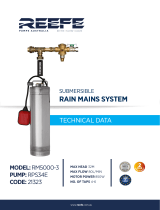 REEFE RM5000-3 Instrukcja obsługi
REEFE RM5000-3 Instrukcja obsługi
-
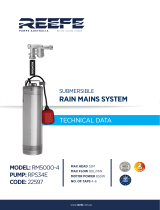 REEFE RM5000-5 Instrukcja obsługi
REEFE RM5000-5 Instrukcja obsługi
-
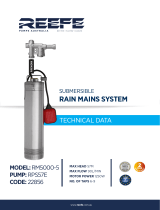 REEFE RM5000-5 Instrukcja obsługi
REEFE RM5000-5 Instrukcja obsługi
-
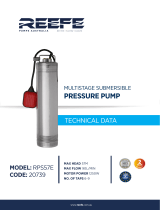 REEFE RPS57E Instrukcja obsługi
REEFE RPS57E Instrukcja obsługi
-
Woods Batwing BW15.60QE Instrukcja obsługi
-
Simplicity ZT2148B Instrukcja obsługi
-
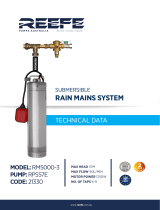 REEFE RM5000-3 Instrukcja obsługi
REEFE RM5000-3 Instrukcja obsługi
-
Sea Ray 2007 44DA Parts Manual
-
DAB DRENAG 1800 T Instruction For Installation And Maintenance
-
DAB KDNE MCE-P Instrukcja obsługi






